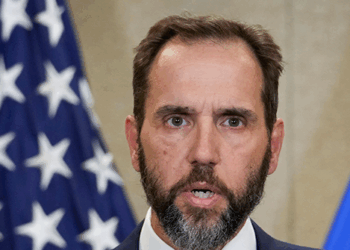During his first official visit to Asia in March, U.S. Defense Secretary Pete Hegseth delivered a strong message to Washington’s allies and partners. “What the Trump administration will do … is truly prioritize and shift [to] this region of the world in a way that is unprecedented, to match the threats of the future,” he said.
This rhetoric aligns with the Pentagon’s Interim National Defense Strategic Guidance, which is designed to serve as a placeholder until a full National Defense Strategy is published later this year. The guidance established the Indo-Pacific as its top priority beyond protecting the homeland. To that end, it committed the United States to “assume risk in other theaters,” namely the Middle East and Europe, to ensure that its military has the personnel, platforms, and equipment necessary to maintain deterrence in East Asia.
The Defense Department, however, does not seem to be following its own recommendations. Instead of focusing on Asia, it has continued to spread itself thin with too many missions in too many regions at once. Without strict prioritization, the Trump administration risks repeating the mistakes of its predecessors, leaving the U.S. military overextended and out of position if a real threat to its interests emerges.
Since President Donald Trump returned to office, the U.S. military has certainly asserted its presence in Asia, particularly in Japan and the Philippines. It has announced and deployed new capabilities, added to existing ones, and conducted trilateral drills in the South China Sea.
Meanwhile, in the Middle East, the Trump administration has not only failed to downsize the U.S. military presence but is actively surging capabilities into the region. The increase responds to several regional threats, but by far the most demanding are the nearly two-month air war against the Houthi rebels in Yemen, which has burned through already depleted munitions stockpiles and resulted in the downing of seven U.S. MQ-9 Reaper drones, and attempts to signal U.S. readiness for military action against Iran as nuclear negotiations play out.
As part of these efforts, Hegseth directed the Harry S. Truman Carrier Strike Group to remain in the Middle East at least a month past its scheduled deployment, and the USS Carl Vinson was rerouted from the Indo-Pacific to reinforce air operations against the Houthis. The United States has also sent additional fighter squadrons to the region, and at least six B-2 bombers—one-third of the U.S. Air Force’s entire B-2 fleet—are now parked at Diego Garcia in the Indian Ocean.
Alongside the increase in offensive firepower, the Pentagon has exerted considerable energy and resources to move more air defenses to the Middle East. For example, in April, a Terminal High Altitude Area Defense (THAAD) missile system reportedly arrived in Israel, meaning that two of the seven THAADs in the U.S. arsenal are now stationed there.
There are few indications that the Trump administration intends for this surge to be temporary. Moreover, although Trump’s May 6 truce with the Houthis could eventually reduce demands on U.S. military forces in the region, it remains to be seen how far-reaching and enduring the cease-fire will be. The truce could be easily undone by renegade Houthi operations, for example, or continued Houthi missiles strikes on Israel, which were not covered by Trump’s deal. Regardless, U.S. Central Command will likely remain cautious and advise against removing U.S. military assets from the region for the time being.
The continued commitment will have consequences. Every military asset delivered to one region means there are fewer available for protecting U.S. interests elsewhere. Air defenses, aircraft carriers, and destroyers—exactly those resources tied up in the Middle East—are also critical for signaling U.S. commitment to allies in Asia and protecting forces against long-range Chinese missiles in places such as Guam and Japan.
The Middle East isn’t the only theater where the Pentagon’s words and deeds don’t align. Senior Trump administration officials have repeatedly sought to compel European countries into spending more on defense. During his first speech to NATO members, Hegseth explained that “strategic realities”—most importantly, U.S. competition with China—would prevent the United States from serving as the primary guarantor of European security. U.S. Vice President J.D. Vance went further by saying that it’s “not in Europe’s interest and it’s not in America’s interest for Europe to be a permanent security vassal of the United States.”
Despite those sentiments, the Trump administration has yet to announce any major changes to the U.S. military footprint in Europe. Some modifications to its European posture are likely, but their timeline and scope are uncertain. Reports that 10,000 U.S. troops might leave Europe, for example, are insufficient when one considers that former U.S. President Joe Biden deployed an additional 20,000 troops to the continent immediately after Russia’s full-scale invasion of Ukraine, bringing the total force size to more than 100,000.
A small withdrawal from Europe would be especially ineffective and unhelpful if, as the United States has done in the past, it was spread out over a long period, giving European leaders and the U.S. national security bureaucracy time to roll back planned posture changes. Real prioritization will require plans for a much more significant and rapid U.S. drawdown and transfer of NATO leadership roles to European allies.
In some ways, the Trump administration’s failure to stick to its own priorities fits the trend of past administrations. Both Biden and former President Barack Obama also hoped to shift resources to Asia and had little success. But following through with prioritization is even more vital today than it was then. Changes in the global balance of power and tightening resource constraints in the United States have increased the potential consequences of the Pentagon’s failure to focus its global activities.
Three major consequences are worth noting.
First, as the United States remains distracted by the Middle East and heavily invested in Europe, China continues to increase, advance, and stockpile its military power in Asia. The military balance in the region is already shifting quickly against the United States, especially as China builds more long-range missiles, better fighter jets, and the world’s biggest navy. The United States does not need to maintain military preeminence in the region to secure its interests, but without the right investments today, even more modest goals could slip out of reach.
For example, there are already questions about the ability of the U.S. military to break a Chinese coercive blockade of Taiwan or to prevent China from seizing the island by force. The United States must meaningfully concentrate on the region soon, with real investments in air defense, uncrewed air and sea systems, undersea capabilities, and base and airfield hardening. Otherwise, questions will arise about its capacity to support allies such as Japan and the Philippines—and even to protect U.S. military assets along the Second Island Chain, such as in Guam, the Marshall and Northern Mariana islands, and Palau. Lack of focus today will eventually limit Washington’s strategic options.
Second, the United States’ failure to prioritize the Indo-Pacific leads to the waste of scarce resources on programs and activities that do not match its interests. In the Middle East, for example, the United States’ stakes are much lower than today’s extensive military commitment to the region would suggest. The Houthis do not pose a real threat to the U.S. homeland, and the United States does not rely on shipping through the Red Sea. Commitments in Europe are similarly out of balance. Even if Russia gains territory and influence from its war on Ukraine, it is not positioned to become a European hegemon that could challenge the United States.
Simply put, the Pentagon’s refusal to shed unnecessary missions squanders money and munitions on causes that do not make the country safer and runs counter to the Trump administration’s focus on increasing government efficiency.
Finally, failure to prioritize increases U.S. exposure to conflicts and instability abroad and raises the risk of entanglement in an unnecessary war. This risk is highest in the Middle East, where a heavy U.S. military footprint, including a constellation of large bases across the Gulf Arab states, means that the United States is implicated any time violence erupts in the region.
If the Pentagon hopes to serve its own stated strategic priorities—deterrence in Asia and protecting the U.S. homeland—it will need to change its behavior.
This will require accepting that the United States does not need to get involved in every conflict in the Middle East or along NATO’s borders. More specifically, prioritization will necessitate a permanent end to the U.S. military campaign against the Houthis and a reduction of the U.S. military presence in the Middle East to at least its pre-October 2023 levels. Finally, it will also require an end to U.S. involvement in Ukraine and faster progress on reducing the U.S. military presence in Europe by sending home the 20,000 surge forces that Biden deployed after Russia’s invasion.
No one expects these changes to happen overnight, but movement in this direction can and should start right away.
The post The Pentagon Is Ignoring Its Own Strategy appeared first on Foreign Policy.




